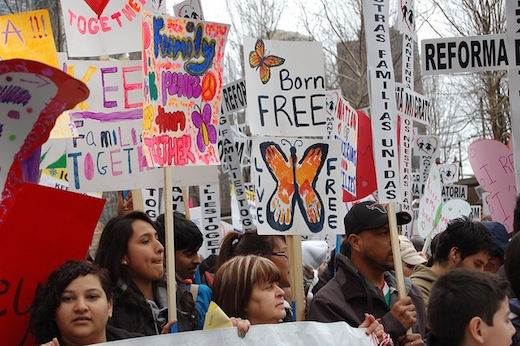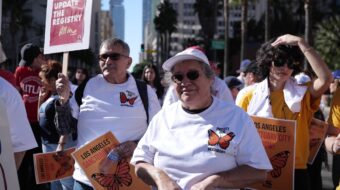
There are reports of progress in labor-business negotiations over new immigration reform legislation. But “street heat” is essential to keep the effort from failing once more.
Organized labor has a big stake in a progressive immigration reform. Of the 11 million undocumented immigrants in the United States today, between 7.5 and 8 million are estimated to be in the labor force. They are employed in a wide range of industrial and service industries that unions would like to organize. Up to now, the marginality and vulnerability of this population has made it extremely difficult for them to join unions and fight for their rights in the workplace. The fear of arrest and deportation has been used by employers to block many organizing drives. On the other hand, the fighting spirit of immigrant workers, seen in the immigrants’ rights movement itself, shows that they would be a great asset to organizing drives and labor actions, if only the problem of their legal status could be resolved. As this would strengthen labor’s bargaining power, it would benefit all workers, immigrant or not.
This is a major reason why the leadership of the AFL-CIO, Change to Win and many individual unions has prioritized legislation to legalize the undocumented this year.
However, organized labor does not control Congress, and big business has its own agenda, which includes securing a supply of cheap labor from which it can derive extra profits, and undercut the rest of the workers. Groups like the U.S. Chamber of Commerce have always pushed for the creation of new guest worker programs. Guest workers are legally in the country, but they are in a vulnerable position, because they can’t change jobs when they are not satisfied with the pay or working conditions. To do so, let alone to go on strike, would invalidate their permission to be in the United States. There are many examples of employers treating guest workers as serfs or worse. Only undocumented workers are worse off.
So labor, as well as the many organizations that constitute the immigrants’ rights movement, are faced with the dilemma that it wants legislation passed, which would legalize the undocumented and regularize the way that new working-class immigrants are brought into the United States, but faces the obstacle of the demand for guest workers by the corporations and most Republican and many Democratic elected officials.
In 2005 and again in 2007, legislation was introduced whereby, in exchange for legalizing the undocumented, with a “path to citizenship,” a certain number of new guest worker slots (up to 400,000 per year) would be created. There would also be new enforcement mechanisms, and the people being legalized would have to jump through many hoops. Some unions whose plan of growth relies heavily on organizing immigrant workers saw the possibility of organizing 8 million newly legalized workers as worth the sacrifice of accepting the guest worker program. But other unions, and the AFL-CIO, would not support a bill which included more guest workers.
In 2009, The AFL-CIO and Change to Win, along with immigrants’ rights groups, developed a model for legislation which would have legalized most of the undocumented while dealing with the issue of guest workers via a labor-business controlled body that would authorize new guest worker positions (or not), based on labor market statistics. Mechanisms were also included which would allow guest workers to eventually get permanent resident visas and so be able to move away from guest worker status to regular employment. This led to the Reform Immigration for America campaign, which most of labor and most immigrants’ rights organizations supported. However it did not make any headway in Congress, partly because it did not get White House support.
Now negotiations between the AFL-CIO and the U.S. Chamber of Commerce have produced an agreement similar to the 2009 one.
A new “W” visa would be created under which new workers from outside the United could be employed in certain industries. Unlike traditional “guest worker” programs, immigrants brought in with a “W” visa could change jobs once here, and could eventually petition for their W visas to be turned into permanent legal residency visas which would allow them to apply for U.S. citizenship. A minimum wage for “W” visa workers would be determined based on either prevailing wage in a given industry or the actual employer wage, whichever is higher. In construction, higher skilled job categories would not be included. “W” visa positions would be phased in, initially capped at 20,000 job slots per year, and going up incrementally over several years but not to exceed 200,000 positions.
President Richard Trumka of the AFL-CIO and President Thomas J. Donahue of the U.S. Chamber of Commerce have signed off on this plan. Now it has to be turned into a legislative proposal, in a Congress in which the Republicans control the House of Representatives and the situation in the Senate is by no means assured.
There will be pressure from far-right Republicans to not allow any legalization of the undocumented at all. Other Republicans, and some Democrats, will try to undo the Trumka-Donovan deal by pushing in the direction of the old kind of guest worker program with increased numbers and radically reduced rights. Others will push to allow legalization, but deny legalized undocumented immigrants the right to eventually apply for citizenship. Yet others will want to keep undocumented immigrants in a limbo state with no rights for years, before they can even be given permanent residency.
After the Easter recess is over, it is expected that the Senate “gang of eight” will produce draft legislation. That will only be the beginning of the struggle. Grassroots pressure is essential. Many protests are planned, including a major mobilization in Washington DC on April 10.
Photo: Children lead a March 26 rally to keep families together and pass meaningful immigration reform in Chicago (PW/Winona Albano Bachtell).












Comments